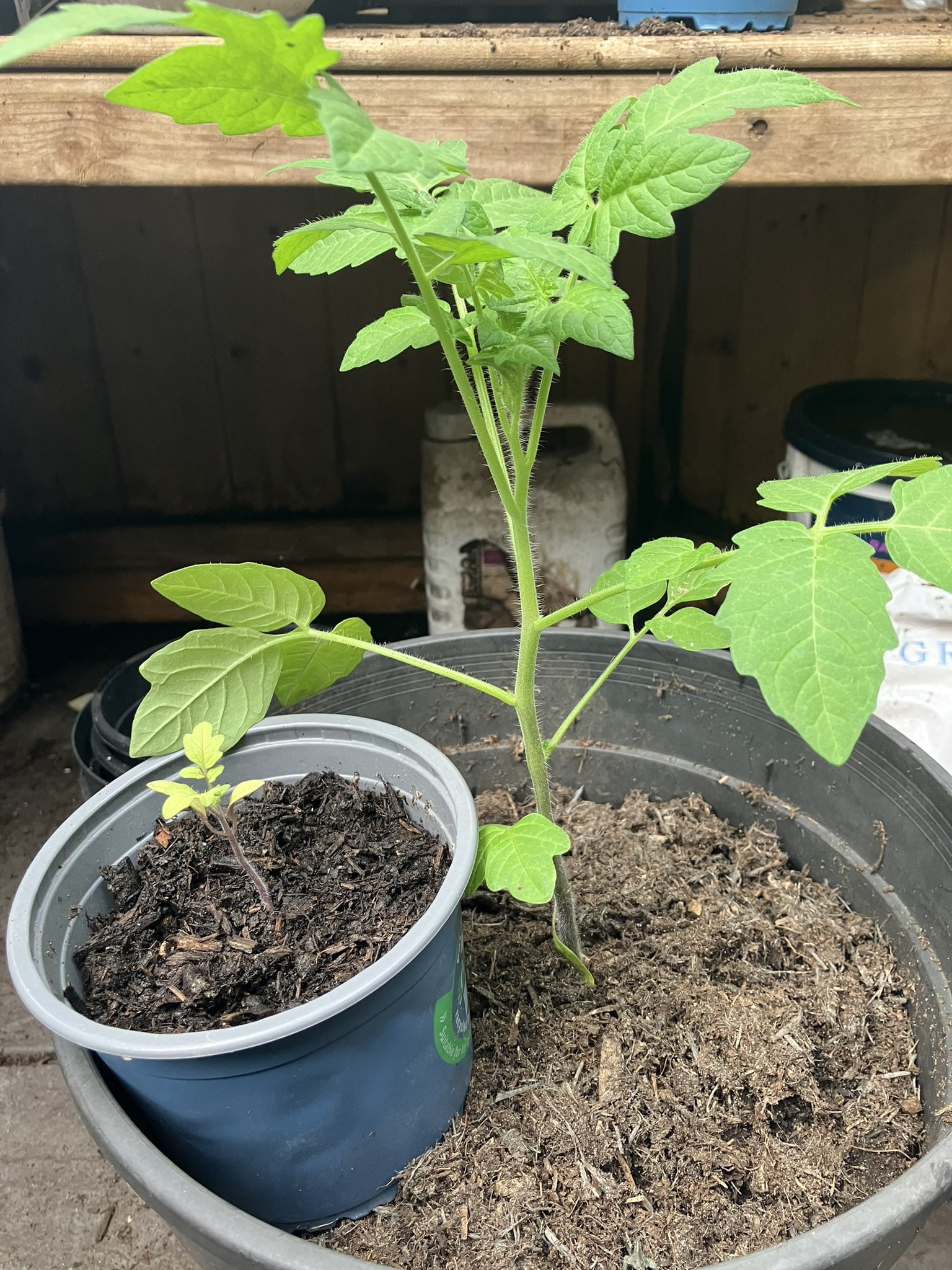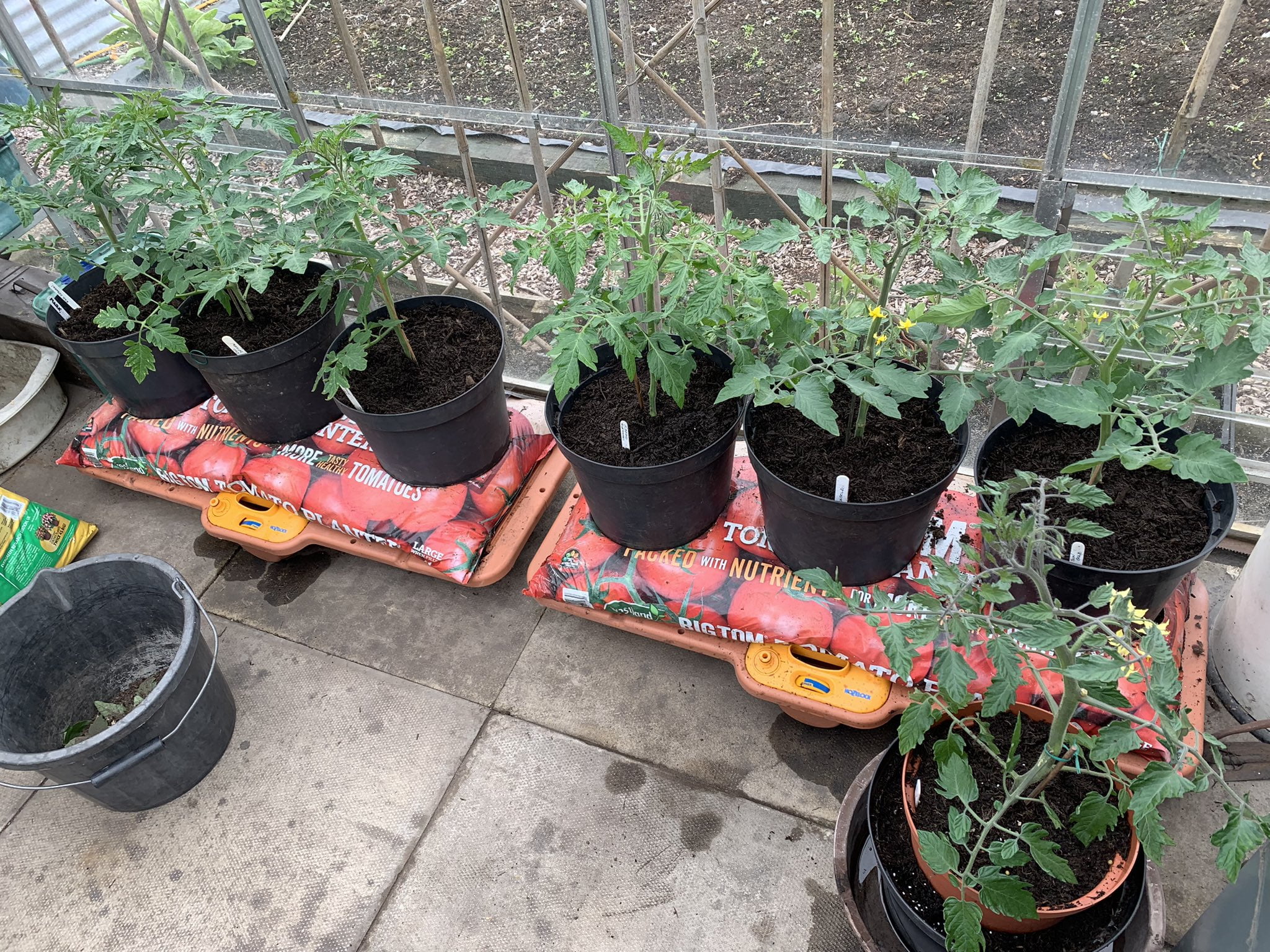Tomato plants, renowned for their vibrant foliage and delectable fruit, thrive remarkably well in container gardening settings. Achieving optimal results, however, necessitates a deep understanding of when to feed tomato plants in pots. In this comprehensive guide, we will delve into the intricacies of feeding tomatoes in containers, uncovering the ideal feeding schedules, essential nutrient components, and techniques for promoting robust growth and abundant harvests.

Table of Contents
The Two Vital Stages On When To Feed Tomato Plants In Pots
Tomato plants embark on a unique journey characterized by two distinct growth stages, each with specific nutritional demands. To effectively determine when and how to feed tomato plants in pots, one must acquaint themselves with these pivotal stages.
Energizing the Initial Stage: Before Flowering

As tomato plants initiate their growth, often referred to as the vegetative stage, their nutritional requirements primarily revolve around establishing a sturdy foundation for future development. During this phase, feeding tomato plants is best accomplished using a balanced general fertiliser, such as the well-known Miracle Grow or similar general feeds.
These fertilisers comprise essential nutrients like nitrogen (N), phosphorus (P), and potassium (K) in relatively balanced proportions, complemented by an array of other vital minerals. However, when formulating a feeding strategy, it’s vital to take into consideration the composition of the compost utilized for potting.
It’s worth noting that fresh potting soil compost, multi-purpose soils, and grow bag soil already hold a reservoir of nutrients. Therefore, the need for additional feeding is generally postponed until these nutrients are depleted, typically occurring after approximately three weeks in smaller pots and around five to six weeks in larger pots or containers.
Fostering Reproduction: After Flowering

When tomato plants get to the critical reproductive stage of flowering and fruiting, their nutritional needs evolve in tandem. During this phase, a more targeted feeding approach becomes crucial for fostering successful development.
Tomato-specific fertilizers come to the forefront during this period, as they are specially formulated to cater to the distinct needs of flowering and fruiting plants. These fertilizers are enriched with higher levels of phosphorus and potassium, two essential elements crucial for promoting the development of flowers and fruits. Phosphorus encourages strong root systems and robust flower formation, while potassium enhances overall plant health and aids in fruit maturation.
However, it’s important to note that while phosphorus and potassium take center stage during this phase, maintaining a well-rounded nutrient balance is still essential for the plant’s overall vitality. This means that other key nutrients such as nitrogen, calcium, and magnesium should not be overlooked, as they contribute to various aspects of plant growth and health.
To further augment growth during this critical phase, consider integrating Liquid Seaweed Extract into your plant care routine. This organic supplement serves as a versatile tool, functioning not only as a root drench but also as a foliar spray. When applied as a foliar spray, it can be absorbed directly by the leaves, promoting vigorous growth and providing plants with an additional source of nutrients and trace elements.
Deciphering the Nutritional Calendar: The Ideal Feeding Times
Feeding tomato plants in pots is a dynamic process that requires precise timing to optimize nutrient assimilation. However, it’s imperative to recognize that new potting compost already contains a substantial amount of nutrients. Consequently, immediate additional feeding post-potting is generally unnecessary.
For instance, a 10-litre pot or a grow bag replete with fresh compost can adequately sustain a plant for a span of approximately four to six weeks before necessitating supplementary feeding.
This timeframe accounts for the nutrients naturally present in the compost, which nourish the plant during its early growth stages. As the plant matures and these initial nutrients gradually deplete, it becomes prudent to initiate a well-calibrated feeding regimen. This strategic approach ensures that the tomato plants access a continuous supply of nutrients tailored to their evolving requirements, thereby fostering robust growth and an eventual bountiful harvest.
Selecting the Right Fuel: Navigating Tomato Food Brands
The market offers an array of tomato food brands, with popular choices including Tomorite and Chempak Standard Tomato Food, each tailored to meet specific nutrient requirements. However, adherence to recommended usage guidelines, as provided on the product packaging, is essential to prevent overfeeding, which could detrimentally impact plant health
Preserving Nutrients: Combatting Nutrient Loss in Grow Bags & Pots
Container-grown tomatoes encounter a unique challenge – the potential loss of nutrients through watering practices. To counteract this, frequent feeding becomes a necessity. This can be achieved by diminishing nutrient strength and adopting shorter intervals for feeding, thereby ensuring a consistent nutrient supply.
To mitigate nutrient washout, consider implementing specialised grow pots when feeding tomato plants in grow bags. This technique entails watering in the outer ring of the pot and feeding within the inner ring encircling the stem base. Notably, different tomato food brands offer options in both liquid and solid forms, such as the liquid Tomorite and the solid Chempak Standard Tomato Food, which can be dissolved in water.
Using these techniques helps you to address the challenge of nutrient loss in container-grown tomatoes, ensuring a consistent and well-preserved nutrient supply for healthy growth and ultimately a fruitful harvest.
The Power of Balance: Striking the Right Feeding Formula

In summary, the art of feeding tomato plants in pots revolves around a delicate balance. Before flowering, general fertilisers play a vital role, while specialised tomato food becomes essential as the plant progresses. Adhering to recommended nutrient strengths, adhering to prescribed feeding schedules, and utilising techniques like grow pots all contribute to maintaining a consistent and harmonious nutrient supply.
The principle of “less is more” holds true when feeding tomatoes. Overfeeding, while well-intentioned, can lead to unintended consequences, including a chemical imbalance within the soil that adversely affects roots, stresses plants, and ultimately diminishes tomato yields.
Overfertilization can disrupt the intricate interplay of nutrients essential for proper growth. An excess of certain nutrients, like nitrogen, can promote excessive vegetative growth at the expense of flowering and fruiting. This imbalance not only compromises the plant’s energy allocation but also heightens its vulnerability to diseases and pests. Furthermore, overfertilization can elevate soil salinity, impeding water absorption and leading to root damage.
Navigating Extreme Conditions: Feeding in Hot and Cold Climates
The complexities of feeding tomato plants are further compounded by the challenges posed by extreme temperatures. In hot weather, a “little and often” strategy for feeding is advisable. Elevated temperatures amplify the plants’ water consumption rate, necessitating a reduction in nutrient concentration and an increase in feeding frequency to adequately fulfill the heightened demand.
Conversely, cold temperatures present a different set of hurdles. Even if nutrients are present in the soil, their absorption is impeded in chilly conditions. Optimal nutrient assimilation occurs when temperatures surpass 10 degrees Celsius (50 degrees Fahrenheit). Furthermore, the population of beneficial soil microbes, which play a pivotal role in maintaining root health and facilitating nutrient uptake, diminishes significantly in colder environments.
To elaborate, high temperatures cause plants to transpire more rapidly, expelling moisture through their leaves. Consequently, this accelerates the need for water and nutrients. Employing a “little and often” approach during these conditions provides a steady stream of nutrients that aligns with the accelerated plant metabolism.
Conversely, during cold spells, tomato plants experience a slowdown in physiological processes, including nutrient uptake. Even if nutrients are present in the soil, the plants struggle to absorb them efficiently due to reduced root activity. This phenomenon can lead to deficiencies and hindered growth.
Moreover, cold temperatures also impact the population of beneficial soil microbes. These microorganisms establish symbiotic relationships with plant roots, aiding in nutrient absorption. However, colder environments discourage their proliferation, impinging on their ability to support healthy root systems.
pH Balance: The Role of Alkalinity and Acidity
Maintaining an optimal pH level is paramount for tomato plants to effectively absorb nutrients. The ideal pH range for cultivating tomatoes hovers around 6.8 in soil, reflecting a slightly acidic environment. Deviations from this range can impede nutrient accessibility, even when nutrients are present in the soil.
In conclusion, nourishing tomato plants in pots entails a multifaceted understanding of growth stages, nutrient requirements, and environmental influences. Embracing a “little and often” philosophy, selecting suitable tomato food brands, and accounting for temperature and pH variations are the cornerstones of successful feeding. By adhering to these guidelines, you’ll pave the way for the flourishing growth and prolific yield of your container-grown tomato plants.
